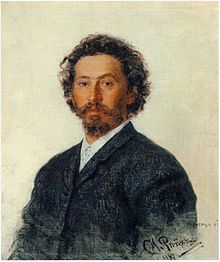
Back Ilja Repin Afrikaans إيليا ريبين Arabic ايليا ريبين ARZ Iliá Repin AST Ilya Repin AVK İlya Repin Azerbaijani Репин Илья Ефимович Bashkir Ілья Яфімавіч Рэпін Byelorussian Ільля Рэпін BE-X-OLD Иля Репин Bulgarian
Ilya Repin | |
|---|---|
Илья Репин | |
 Self-portrait (1887), Tretyakov Gallery, Moscow | |
| Born | 5 August [O.S. 24 July] 1844 |
| Died | 29 September 1930 (aged 86) |
| Nationality | Russian[1] |
| Alma mater | Imperial Academy of Arts (1871) |
| Known for | Painting |
| Notable work | Barge Haulers on the Volga (1870–1873) Religious Procession in Kursk Province (1880–1883) Reply of the Zaporozhian Cossacks (1880–1891) |
| Movement | Realism Peredvizhniki[2] |
| Awards | Legion of Honour (1901) |
| Patron(s) | Pavel Tretyakov |
| Signature | |
 | |
Ilya Yefimovich Repin[a] (5 August [O.S. 24 July] 1844 – 29 September 1930) was a Russian painter who was born in what is now Ukraine.[1][4][5][6][b] He became one of the most renowned artists in Russia in the 19th century. His major works include Barge Haulers on the Volga (1873), Religious Procession in Kursk Province (1880–1883), Ivan the Terrible and His Son Ivan (1885); and Reply of the Zaporozhian Cossacks (1880–1891). He is also known for the revealing portraits he made of the leading Russian literary and artistic figures of his time, including Mikhail Glinka, Modest Mussorgsky, Pavel Tretyakov, and especially Leo Tolstoy, with whom he had a long friendship.
Repin was born in Chuguev, in Kharkov Governorate of the Russian Empire. His father had served in an Uhlan Regiment in the Russian army, and then sold horses.[8] Repin began painting icons at age sixteen. He failed at his first effort to enter the Imperial Academy of Fine Arts in Saint Petersburg, but went to the city anyway in 1863, audited courses, and won his first prizes in 1869 and 1871. In 1872, after a tour along the Volga River, he presented his drawings at the Academy of Art in St. Petersburg. The Grand Duke Alexander Alexandrovich awarded him a commission for a large scale painting, The Barge Haulers of the Volga, which launched his career. He spent two years in Paris and Normandy, seeing the first Impressionist expositions and learning the techniques of painting in the open air.[9]
He suffered one setback in 1885 when his history portrait of Ivan the Terrible killing his own son in a rage caused a scandal, resulting in the painting being removed from exhibition. But this was followed by a series of major successes and new commissions. In 1898, with his second wife, he purchased a country house, The Penates, in Kuokkala, Finland (now Repino, Saint Petersburg), close to St. Petersburg, where they entertained Russian society.[9]
In 1905, following the repression of street demonstrations by the Imperial government, he quit his teaching position at the Academy of Fine Arts. He welcomed the February Revolution in 1917, but was appalled by the violence and terror unleashed by the Bolsheviks following the October Revolution. In 1917, Russia lost control over the Grand Duchy of Finland, leading to the full independence of Finland. Following this event, Ilya Repin was unable to travel to St. Petersburg (renamed Leningrad), even for an exhibition of his own works in 1925. Repin died on 29 September 1930, at the age of 86, and was buried at the Penates. His home is now a museum and a UNESCO World Heritage Site.[10]
- ^ a b "Ilya Yefimovich Repin | Biography, Art, & Facts". Encyclopedia Britannica. Retrieved 31 December 2020.
Ukrainian-born Russian painter
- ^ Moskvinov, V. N. (1955). Репин в Москве. Moscow: Государственное издательство культурно-просветительской литературы. p. 32.
- ^ "Спецпроєкт "Справжні". Ілля Ріпин: художник, якого намагається привласнити росія - Фільтр". Retrieved 15 June 2023.
- ^ Iovleva, L. I. (2003). "Repin, Il'ya". Grove Art Online. Vol. 1. Oxford University Press. doi:10.1093/gao/9781884446054.article.t071521. ISBN 978-1-884446-05-4.
Russian of Ukrainian birth
- ^ "Repin, Ilya Efimovich", Benezit Dictionary of Artists, Oxford University Press, 31 October 2011, doi:10.1093/benz/9780199773787.article.b00151213, ISBN 978-0-19-977378-7, retrieved 19 January 2023,
Ukrainian, 19th–20th century, male. Active in Finland from 1917. ... Ilya Efimovich Repin was the son of a soldier-settler from the Russian Army. In later life he would draw on his birthplace for the subject matter in works such as The Zaporozhe Cossacks Writing a Reply to the Turkish Sultan.
- ^ "ULAN Full Record Display: Repin, J. J. (Russian painter, 1844-1930)". Union List of Artist Names (Getty Research). Retrieved 19 January 2023.
Nationalities: Russian (preferred) / Ukrainian
- ^ Lang, Walther K. (2002). "The Legendary Cossacks: Anarchy and Nationalism in the Conceptions of Ilya Repin and Nikolai Gogol". Nineteenth-Century Art Worldwide. 1 (1).
Though Ilya Repin was born and brought up in the Ukraine and spoke fluent Ukrainian, he considered himself a Russian.
- ^ Sternine & Kirillina 2011, p. 14.
- ^ a b Ilya Repin- Peindre l'âme Russe, Claude Pommereau (editor), Beaux Arts Editions, Paris, October 2021, p. 15 (in French)
- ^ Ilya Repin- Peindre l'âme Russe, Claude Pommereau (editor), Beaux Arts Editions, Paris, October 2021, p 15-17 (in French)
Cite error: There are <ref group=lower-alpha> tags or {{efn}} templates on this page, but the references will not show without a {{reflist|group=lower-alpha}} template or {{notelist}} template (see the help page).